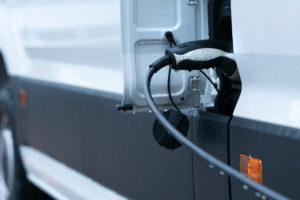In a 3-part blog series, we cover a range of challenges facing the electrification of transportation and what’s being done about it.
In a seeming mindset tipping point on the future of electrification, EV sales have soared globally. From 2019 to 2021 the sales numbers quadrupled. Worldwide, a 75% increase in 2022 over 2021 shows EV transition is still going strong. Yet with only a 9% rise (compared to 65% in 2021) in Europe’s EV sales this year, it’s plain to see that many factors can present challenges and even barriers on the road to electrification.
Electric vehicle supply chain challenges
You’ve made the decision to start electrifying your fleet. Your first batch of transport EVs is ordered, but you won’t see them for another 2 years! Why? Battery or chip shortage, a special part, Covid-19 or crisis brought on by war — it could be all of the above.
Today’s common EV batteries (NMC) need lithium, nickel, cobalt and other raw materials for production. Russia just happens to control a good portion of global nickel and cobalt supply & extraction infrastructure. Lithium too has gone up. Australia is a big supplier, but demand is hard to maintain. Lithium supply, rich in south American countries, is so far rather unreliable from an organizational standpoint. China has lithium but needs it for their own production — where EV sales still boom. Now, throw in a global semiconductor shortage!
Compounded by Covid-19 lockdowns, production personnel shortages, more oil & gas volatility effects, energy prices and inflation and you start to see why EV transition can potentially start to lose its spark.
But to escape from what Elon Musk calls “production Hell”, many solutions must be implemented for times like these. Policies like Biden’s recent Defense Production Act will boost battery & chip production. This should support sustainable national mineral sourcing, reduce import reliance and buffer the effects of geopolitical conflict.
Producing more lithium iron phosphate (LFP) batteries versus NMC batteries can effectively reduce mineral supply problems and promote sustainability. Semiconductors are produced from silicon and chips are in almost everything today. Using materials like SiC (silicon carbide) and GaN (gallium nitride) as alternatives to silicon could ease the supply chain for chip production.
Hopefully, as the aftermath of Covid-19 subsides, the predicted return to normal supply-chain flows in 2023 and a more stable economic-geopolitical world will bring us back from the brink!
People & planet challenges
It’s glaringly clear that a planet congested with gasoline-powered combustion engine vehicles (ICE) will further push the climate crisis. It’s also a fact that EV production is also not a 100% green venture so far.
EVs run zero emission, but factory emissions from production & fossil-fuel energy use are high. Factor in charging grid energy sources, mineral mining for batteries or even particulate dust from tires, and it’s clear that EV manufacturing and energy infrastructure needs to be greener. Like many challenges, solutions already exist, they just need to be further implemented and scaled up.
So, what can be done?
- Uncoupling renewable energy from oil & gas price models to make renewables immune to fossil-fuel market volatility and higher prices.
- Making mining more decentralized and as sustainable as possible.
- Ramp up the Gigafactory-model of mineral sourcing & local production for batteries.
- Investment in Microfactory-model startup EV makers (like Arrival) for greener, more localized production.
- Promoting battery recycling infrastructure.
- Promoting battery innovation like cheaper, cleaner LFP batteries.
- More innovation and use of airless, heavier EV-specific tires made from recycled or biomass materials.
Although people are embracing the EV more and more, not everyone is convinced. This, to a degree, is made possible by lobbying & thinktanks manipulating political processes. Fossil-fuel giants must protect their interests, so they will pay to stay above water by influencing public (and civic) opinion — by greenwashing, “sponsoring” political action groups, gaming the regulations and generally staying opaque.
Fears like range anxiety or getting stuck without a charger are becoming mere myth as battery & infrastructure technology advances. So far, incentives by governments & OEMs, like subsidies, special access or tax breaks as well as net zero goals and emissions regulations largely drive EV adoption.
The big transport & logistics companies like Amazon or national postal agencies are already slowly but surely electrifying their fleets. As OEMs roll out more e-transport vans and even heavy-duty truck (eHDV) models, mid- and last-mile transport has more chance of becoming electric more quickly.
That’s good news for the planet.
EV ownership cost challenges
EVs are too expensive! And the supply chain issues mentioned above have caused prices to rise even further in 2022. Battery production cost remains the prime reason EVs are more expensive than their ICE competitors. Nonetheless, costs are sinking quickly as battery technology advances. Providing this continues, then predictions pointing to EV to ICE price-parity in 2025 may become reality.
In the long run, electric vehicles have a lower total cost of ownership (TCO). But the initial purchase costs still outweigh the attraction for buyers compared to cheaper ICEs. While the EV sticker price can be significantly higher, the actual individual cost comparisons (aside from batteries) are rather surprising.
What makes EVs so much more expensive?
- Batteries are the main driver for higher costs in EVs.
- EV depreciation & interest rates are higher than ICEs due to a higher sticker price.
- Insurance for EVs is higher than for ICE vehicles — due to higher sticker prices and vehicle weight.
- Tires must be replaced more often with EVs due to more weight and torque which accelerates wear & tear.
So, what are the TCO advantages of EVs?
- Taxes for EVs are significantly lower than ICEs due to government incentives.
- Many countries offer subsidies for EV purchases.
- EV maintenance is less frequent and cheaper as there are fewer moving parts.
- Electrical power is far cheaper (about 50%) than gasoline — especially when sourced from renewable energy.
According to a report comparing a VW Golf vs a VW ID.3 EV from Leaseplan, the TCO for EVs actually turns out to be around 1% cheaper than for ICEs. Wow!
So, in the long run scenario, an electric vehicle that has a longer lease-life and racks up a lot of mileage continues to make TCO more attractive than an ICE vehicle.
That’s good news for transport & logistics fleets.
Continue reading in part 2 of this PANION blog series, where we focus on the specific challenges of electrifying commercial transportation.




